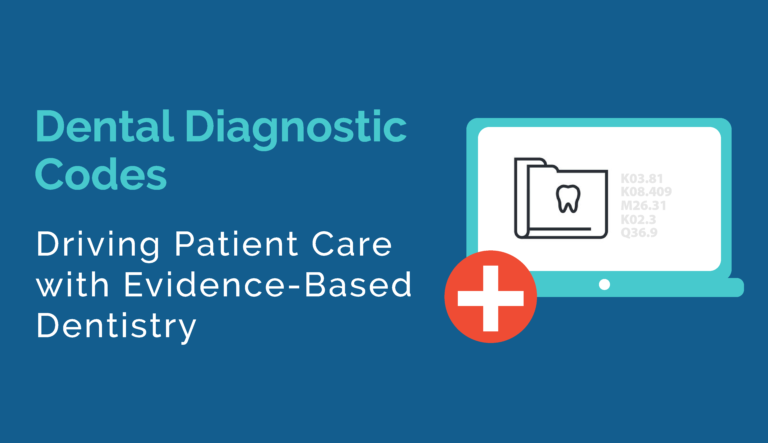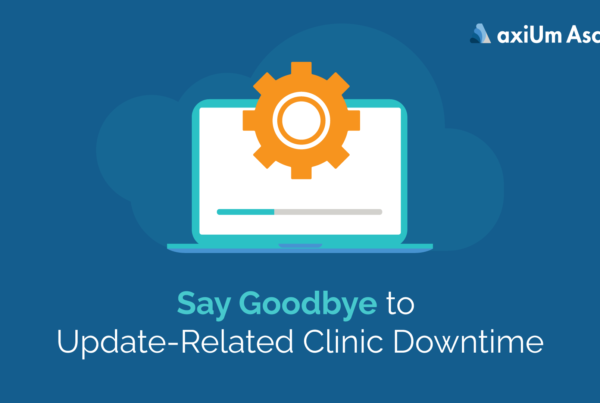Evidence-based dentistry is the integration of a dentist’s clinical expertise, the patient’s needs and preferences, and the most current, clinically relevant evidence. All three are part of the decision-making process for patient care. Assisting practitioners and improving the public’s oral health by appraising and disseminating the best available scientific evidence on oral health care helps providers understand and apply the best available evidence in their clinical decision-making. Evidence is key to delivering excellent patient outcomes in dentistry. Dental providers should base their treatment decisions on research, evidence, and shared decision-making. Including patients in the process by informing them of their treatment choices, including risks, benefits, and costs, helps patients decide on the best treatment. Remaining current in dental research and well-versed in evidence of contemporary best practices solidifies patient trust, commitment to care, and a yearning to improve on an ongoing basis.
Click here to watch a brief demonstration of dental diagnostic codes within axiUm.
The Value of Dental Diagnostic Codes
Every dental provider thinks about diagnosis in his or her head. The current workflow is that a provider has a finding, which then determines the appropriate procedure; this ties procedures to findings, rendering the critical thinking necessary for diagnosis “useless.” We can all agree that teaching critical thinking and diagnosis is imperative to cultivating excellent soon-to-be dentists at our dental schools. There needs to be a shift to teaching students how to examine, evaluate, and then systematically enter a diagnosis to cement the critical thinking process.
A systematic diagnosis exists in a standardized format that seamlessly integrates with axiUm’s Electronic Health Record (EHR), which helps drive diagnosis, procedure quality, and profitable outcomes. The goal of implementing dental diagnostic codes is to improve quality standards. The question, “did I do the right procedure for this finding?” is only asked when a provider has not solidified the diagnosis before treatment. The margin of error for appropriate treatment greatly diminishes as soon as we prioritize diagnosis beforehand.
- Systematic diagnosis cements the critical thinking process.
- Standardized format seamlessly integrates with axiUm’s EHR.
- The standardized format also drives diagnosis, procedure quality, and profitable outcomes, which leads to improved quality standards and a diminished margin of error.
A Necessary Culture Shift
Approximately $250 billion of dentistry is performed annually in the US. Five percent, $12.5 billion, is abuse and fraud (Schroeder, 2017).
A culture shift that targets the quadruple aims — better care, better health, cost-efficiency, and an engaged workforce — is necessary to implement an evidence-based care model within the dental school. These are all the things that resonate in dentistry if we do an excellent job as leaders. When clinics adopt dental diagnostic codes, they can fulfill these aims. Better care is reinforced by the diagnosis-before-treatment model, which is facilitated by evidence-based care. Dental diagnostic codes also deter students from inputting placeholder diagnoses that sometimes are never re-visited. Better health is supported by an increase in accurate diagnoses, as the predictive analytics feature of dental diagnostic codes helps students pinpoint problems more precisely.
Attaching a diagnosis to the treatment increases the likelihood of insurance reimbursement. Your institution’s workforce is more engaged because evidence-based dentistry motivates commitment to learning and care in patients, students, and faculty. Faculty must teach students to begin with diagnosis and to tie it to their treatment plan immediately. Students must interact more diligently with the patient and software to ensure the proper diagnosis is made and reported. Patients may become empowered to learn more about how oral healthcare impacts their overall health and how overall health impacts their oral health by understanding their diagnosis and treatment holistically.
Dental Diagnostics Support Best-Practice Clinical Care
Some faculty find that when evidence-based dentistry is not implemented in the dental school, students are not mandated to think about diagnosis in the treatment planning process. For example, a student who does not prioritize evidence-based care may input most diagnoses as periodontal issues or “carries risk high”; this causes the data to become unreliable. When researchers want to mine the data in axiUm, there is an enormous sum of unusable data.
Often, private practitioners do not worry about the diagnosis. They know what procedure to perform and which procedures are most likely covered by the patient’s insurance plan. Typically, faculty teaching dental students are also private practitioners. In this way, teaching may not emphasize evidence-based care, and students may not learn its importance. Faculty need to take education to the next level by challenging students to think critically and to examine, evaluate, diagnose, discuss, and then treat. By making this shift, dentists and dental students can declare that they are following the medical model, as in the medical model, diagnosis is required to secure insurance for treatment.
Dental Diagnostics Reinforce Best-Practices in Teaching
On the teaching side, diagnosis is foundational because diagnosis leads to better care. Frequently, dental providers are more inclined to plan a procedure before determining the diagnosis. Many dental schools want to teach students that diagnosis is the foundation that leads to treatment planning and care because that workflow encourages critical thinking and systematic delivery of care.
axiUm supports dental diagnostic codes and the diagnosis before care model. Here, you can find a demonstration of dental diagnostic codes within axiUm. axiUm’s Treatment Plan Module supports the diagnosis to treatment plan workflow because the software has built-in clinic decision support. It prompts providers with predictive analytics to help identify possible procedures for a given diagnosis.
Dental school faculty are teaching dental students to be critical thinkers. In collaboration with axiUm, dental diagnostic codes force critical thinking from a clinic workflow perspective; here is a recommended workflow for a dental student:
- Input the findings
- Enter the diagnosis
- Enter the procedure, tying the diagnosis to the procedure
If the student needs to add another procedure, axiUm prompts, “what diagnosis is this procedure tied to?”. The dental student is urged to think, “this is not only the execution of this procedure, but there is also a reason behind it.” Thus, teaching allows faculty on the clinic floor to see the diagnosis and reason for care, providing the ability to verify students’ critical thinking or determinations. In this way, faculty can prove that students can make accurate diagnoses and do most of the time.
Clinical Administration & Financial Remuneration
Dental diagnostic codes help organize clinic administration and ensure appropriate financial remuneration when codes are mandated on claims for certain dental treatments. With these codes, dental schools will receive more revenue from insurance carriers because they will have fewer rejected claims; this equates to a considerable increase in billing value.
If an insurance company rejects a treatment bill, having the diagnosis allows the biller to defend the treatment claim, ensuring they get paid more quickly. When a dental school has a higher acceptance rate of claims, they will have a higher payment rate from insurance companies. In sum, the revenue comes more quickly, diminishing lag time, and claim justification is completed without the added discussion time between dental providers and finance administration at the clinic.
For example, a primary use-case for dental diagnostic codes at the University of California San Francisco (UCSF) is that the state dental care program, Denti-Cal, mandates approval and authorization before treatment for coverage. By using diagnoses, UCSF can do internal approvals and pre-authorizations for care; therefore, they do not have to delay patient care as treatment can be approved internally by specially authorized faculty. For dental schools in California, University Projects using Denti-Cal necessitate accurate diagnoses. Almost all covered benefits require a diagnosis, and it must be correct; an inaccurate diagnosis can trigger a denial of payment or a “claw-back” of a payment. Denti-Cal audits are every six months among Californian dental schools, so their financial information must be up-to-date and accurate.
axiUm’s Diagnosis-Before-Treatment Workflow
Exan is a leader in this diagnostic-centric diagnosis-before-treatment workflow. Alongside the ADA, we are committed to standardized interface terminology. Our partnership with COHRI (Consortium for Oral Health Research and Informatics) allows us to support dental diagnostic codes within our system, supporting evidence-based care in dental schools. If you are interested in implementing or updating your dental diagnosis codes within axiUm, our Support team can assist you.
axiUm’s Tx Planning module supports defining and linking dental problems with diagnosis codes. It suggests and links appropriate treatments based on the diagnosis. Tx Planning is an axiUm add-on module.
We have updated our best practices version so that every new school that requests dental diagnostic codes will receive the updated version.
Dental Diagnostic Code Libraries Available to You
Diagnostic codes are better for healthcare, for reimbursement, and for instructing your students. The research and development from UCSF propel the education of evidence-based dentistry in dental schools today and is why the federal government has now standardized dental diagnostics.
The standardized ADA dental diagnostic codes (SNODENT) are updated regularly by the ADA. Exan has a subset of SNODENT that can be implemented within your academic dental software.
COHRI’s set of SNODDS codes are an extensive set of dental diagnostic codes that include new periodontal diagnoses, periodontal disease classification, and an interface terminology made specifically for axiUm’s EHR.
For More Information
If you are interested in loading the SNODENT subset of codes or the SNODDS codes in axiUm, please contact Exan Software’s Support Team at axiumsupport@exansoftware.com.
Click here to watch a brief demonstration of dental diagnostic codes within axiUm.
References
Schroeder, E. (2017, April 27). Dental Fraud: A $12.5 Billion Dollar Problem. Pharmacists Mutal, 1.
White, D. J. (2020, October 2). Dental Diagnostic Codes.
(Obadan-Udoh et al. 2017)
(White et al. 2011)
(Kalenderian et al. 2016)
(Kalenderian et al. 2011a)
(Kalenderian et al. 2011b)
(Tokede et al. 2013a; Tokede et al. 2013b; Yansane et al. 2019)
Kalenderian E, Ramoni RB, White JM, Schoonheim-Klein ME, Stark PC, Kimmes NS, Patel VL, Walji MF. 2011a. The importance of using diagnostic codes. Oral Surg Oral Med Oral Pathol Oral Radiol Endod. 112(1):4-5; author reply 5.
Kalenderian E, Ramoni RL, White JM, Schoonheim-Klein ME, Stark PC, Kimmes NS, Zeller GG, Willis GP, Walji MF. 2011b. The development of a dental diagnostic terminology. J Dent Educ. 75(1):68-76.
Kalenderian E, Tokede B, Ramoni R, Khan M, Kimmes N, White J, Vaderhobli R, Yansane A, Feilzer A, Walji M. 2016. Dental clinical research: An illustration of the value of standardized diagnostic terms. J Public Health Dent. 76(2):152-156.
Obadan-Udoh E, Simon L, Etolue J, Tokede O, White J, Spallek H, Walji M, Kalenderian E. 2017. Dental providers’ perspectives on diagnosis-driven dentistry: Strategies to enhance adoption of dental diagnostic terminology. Int J Environ Res Public Health. 14(7).
Tokede O, Walji M, Ramoni R, White JM, Schoonheim-Klein M, Kimmes NS, Vaderhobli R, Stark PC, Patel VL, Kalenderian E. 2013a. Treatment planning in dentistry using an electronic health record: Implications for undergraduate education. European journal of dental education : official journal of the Association for Dental Education in Europe. 17(1):e34-43.
Tokede O, White J, Stark PC, Vaderhobli R, Walji MF, Ramoni R, Schoonheim-Klein M, Kimmes N, Tavares A, Kalenderian E. 2013b. Assessing use of a standardized dental diagnostic terminology in an electronic health record. J Dent Educ. 77(1):24-36.
White JM, Kalenderian E, Stark PC, Ramoni RL, Vaderhobli R, Walji MF. 2011. Evaluating a dental diagnostic terminology in an electronic health record. J Dent Educ. 75(5):605-615.
Yansane A, Tokede O, White J, Etolue J, McClellan L, Walji M, Obadan-Udoh E, Kalenderian E. 2019. Utilization and validity of the dental diagnostic system over time in academic and private practice. JDR Clin Trans Res. 4(2):143-150.





Great Job Exan! Thank you for implementing SNODENT into your axiUm software. The interface diagnostic terms, SNODDS, within axiUm represents the best practices for diagnostic terms use in dentistry. Exan continues to be a leader in dentistry and SNODDS within your software puts you at the very top for being diagnostic centered providing evidenced based clinical decision support for your clients!